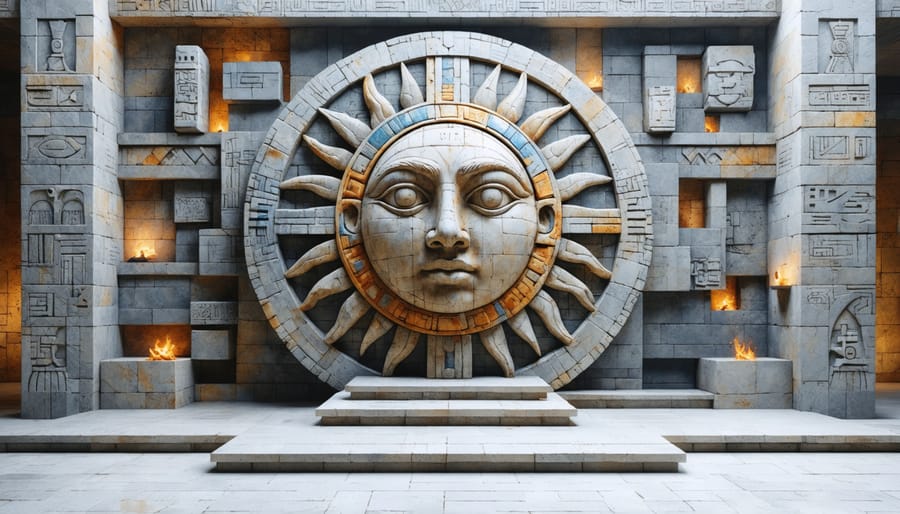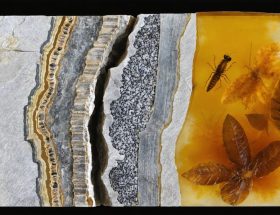Carved into the very soul of Mesoamerican civilization, Aztec stone art stands as one of humanity’s most remarkable achievements in sculptural mastery. From colossal monuments to intricate ceremonial pieces, these masterworks combine raw power with sophisticated artistic vision, reflecting a complex cosmology and unparalleled technical skill. The Aztec sculptors transformed volcanic rock into dynamic representations of gods, rulers, and cosmic forces, using only stone tools and an intimate understanding of their materials. Their works weren’t merely decorative—they served as physical manifestations of Aztec religious beliefs, political power, and cultural identity, encoding complex narratives through symbolic elements and precise geometric patterns. Today, these stone artifacts provide an invaluable window into one of history’s most fascinating civilizations, revealing both the technological brilliance and profound spiritual beliefs of the Aztec people. Modern scholars continue to uncover new layers of meaning in these ancient works, while contemporary artists draw inspiration from their enduring aesthetic power and technical sophistication.
The Sacred Nature of Aztec Stone Craftsmanship
Stone Selection and Symbolism
The Aztecs displayed remarkable sophistication in their selection of stones, choosing specific materials not just for their physical properties but for their deep spiritual significance. Basalt, a dark volcanic rock abundant in the Valley of Mexico, represented strength and permanence, making it the preferred choice for ceremonial sculptures and architectural elements. The highly prized green jade symbolized water, fertility, and life itself, reserved primarily for royal and religious artifacts.
Serpentine, with its distinctive green hue and smooth texture, was associated with renewal and rebirth, while red tezontle stone represented blood and sacrifice in Aztec cosmology. Obsidian, a black volcanic glass, held particular importance as a symbol of darkness, divination, and the underworld. The Aztecs often selected stones based on their color associations with cardinal directions: blue-green for south, red for east, white for west, and black for north.
The selection process involved careful consideration of both practical and symbolic aspects, with master craftsmen choosing stones that would not only withstand time but also properly convey the intended spiritual message through their natural properties and cultural meanings.
Tools and Techniques
The Aztec artisans employed sophisticated early stone carving techniques using primarily stone and obsidian tools. Their most common implements included hammerstones made from harder materials like basalt, chisels crafted from jade and flint, and abrasive tools using sand and water for smoothing surfaces. The carvers typically began with rough shaping using hammerstones, followed by detailed work with smaller tools.
A distinctive aspect of Aztec stone working was their use of string-saw techniques, where cord combined with water and abrasive sand could cut through even the hardest stone materials. This method proved particularly effective when creating precise geometric patterns and clean edges in architectural elements.
For intricate relief carvings, artisans employed pointed stone tools and obsidian blades, which could achieve remarkably fine detail despite their relative simplicity. The final finishing often involved burnishing with smooth stones and natural abrasives to achieve different surface textures, from high polish to intentionally rough finishes that caught light dramatically.
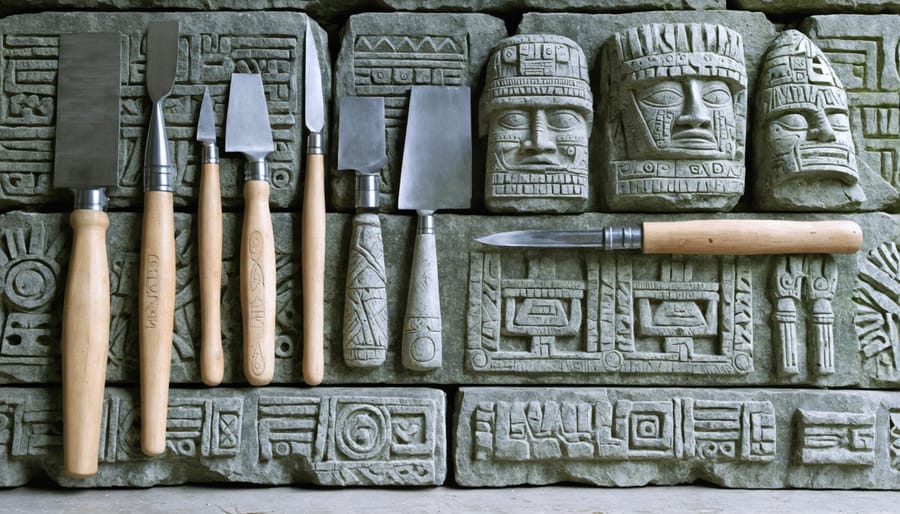
Iconic Aztec Stone Art Forms
Monumental Sculptures
The Aztecs created massive stone sculptures that dominated their ceremonial centers and public spaces, building upon earlier Mesoamerican stone sculpture traditions. These monumental works, often weighing several tons, showcased both technical mastery and profound spiritual significance. The most famous example is the Sun Stone, a 24-ton basalt disk measuring 11.75 feet in diameter, which served as both a religious symbol and astronomical calendar.
Aztec sculptors demonstrated remarkable precision in creating these large-scale works, using only stone tools to carve intricate details into incredibly hard materials like basalt and andesite. Notable monuments include the Coatlicue statue, standing over 8.7 feet tall, which depicts the mother goddess through a complex arrangement of serpents, skulls, and sacred symbols.
These sculptures were typically integrated into architectural complexes, particularly around temple pyramids and ceremonial platforms. The positioning of these works was carefully planned to maximize their visual impact and religious significance. Many featured polychrome paint treatments, though most of these colors have been lost to time.
Modern archaeological evidence suggests these monuments required sophisticated engineering knowledge for transportation and installation, with some sculptures being moved distances of over 25 miles from quarry sites to their final locations.
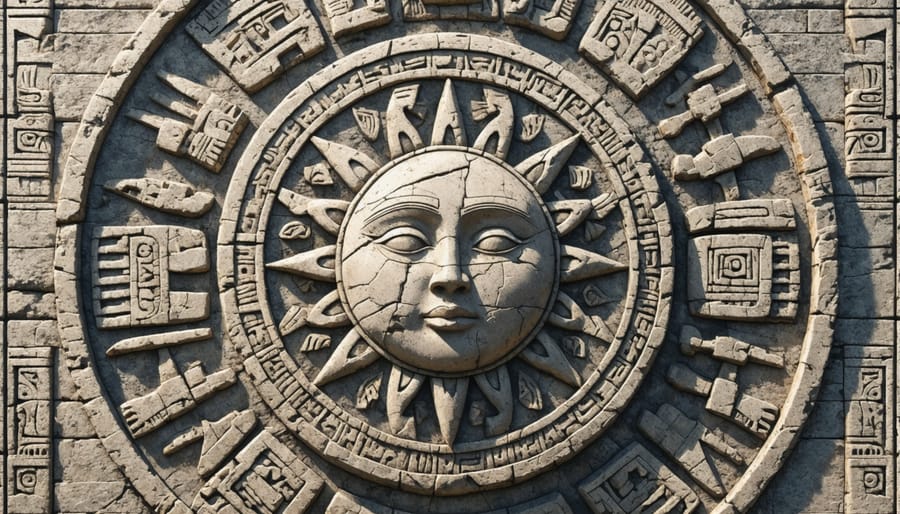
Relief Carvings
Relief carvings were a cornerstone of Aztec architectural decoration, serving both aesthetic and narrative purposes. These intricately carved stone panels adorned temple walls, platforms, and ceremonial buildings throughout Tenochtitlan and other major cities. The artisans employed various carving depths, from subtle low reliefs to dramatic high reliefs, creating dynamic visual stories that seemed to emerge from the stone surfaces.
The most renowned examples include the Calendar Stone and the Stone of Tizoc, which showcase the exceptional skill of Aztec sculptors in creating detailed scenes within a confined space. These reliefs typically depicted religious ceremonies, military conquests, and important historical events, using a sophisticated visual language of symbols and pictographs.
Architectural elements frequently featured serpents, eagles, and divine beings carved in bas-relief, with surfaces carefully smoothed and detailed to capture intricate textures like feathers and scales. The artisans used specialized stone tools, including obsidian implements, to achieve precise cuts and fine details in materials ranging from soft volcanic rock to dense basalt.
Modern archaeological studies reveal that many of these reliefs were originally painted in vibrant colors, though most have weathered to their natural stone tones over centuries. The technical precision and artistic sophistication of these carvings continue to influence contemporary architectural design, particularly in Mexico and the American Southwest, where designers incorporate similar relief techniques into modern building facades.
Ceremonial Objects
The Aztecs created numerous smaller stone artifacts for ceremonial and religious purposes, reflecting their deep spiritual beliefs and cultural practices. These objects ranged from handheld ritual items to elaborate offering boxes and sacrificial vessels. Among the most significant were chalices carved from basalt and serpentine, used during important ceremonies to hold sacred liquids or offerings to the gods.
Ceremonial knives, crafted from obsidian and flint, served both practical and symbolic functions in religious rituals. These blades featured intricately carved handles depicting deities and sacred symbols, demonstrating the Aztec artisans’ exceptional skill in working with delicate stone materials.
Incense burners, or copalli, were another crucial category of ceremonial objects. Carved from volcanic stone, these vessels often featured elaborate relief work showing religious imagery and geometric patterns. The smoke rising from these burners was believed to carry prayers to the gods.
Small stone figurines representing deities and spiritual entities were common in household shrines and temples. These ranged from simple representations to complex sculptures with detailed attributes of specific gods. Personal ornaments, including ear spools and lip plugs made from jade and other precious stones, served as both decorative elements and markers of social status in Aztec society.
Many of these ceremonial objects have survived to the present day, providing valuable insights into Aztec religious practices and artistic achievements.
Modern Applications and Influence
Contemporary Architectural Elements
Modern architects and designers continue to draw inspiration from Aztec stone artistry, incorporating these ancient elements into contemporary buildings. The National Museum of Anthropology in Mexico City stands as a prime example, featuring a massive concrete umbrella supported by a single pillar, adorned with Aztec-inspired stone reliefs that pay homage to pre-Hispanic design principles.
The Torre Reforma in Mexico City seamlessly blends Aztec geometric patterns into its façade, using modern materials while maintaining traditional stone design elements. The building’s triangular form and textured concrete surfaces echo the stepped pyramids of ancient Tenochtitlan.
Several cultural centers across the Americas have embraced Aztec stone aesthetics in their architectural designs. The Anahuacalli Museum, designed by Diego Rivera, incorporates volcanic stone and geometric patterns that reference Aztec temple architecture. Similarly, the Latino Cultural Center in Dallas, Texas, features a contemporary interpretation of Aztec stonework through its angular walls and decorative elements.
These modern interpretations demonstrate how ancient Aztec stone art principles can be successfully adapted to contemporary architecture while preserving their cultural significance and visual impact. Architects continue to find innovative ways to incorporate these historical elements into sustainable, functional modern structures.
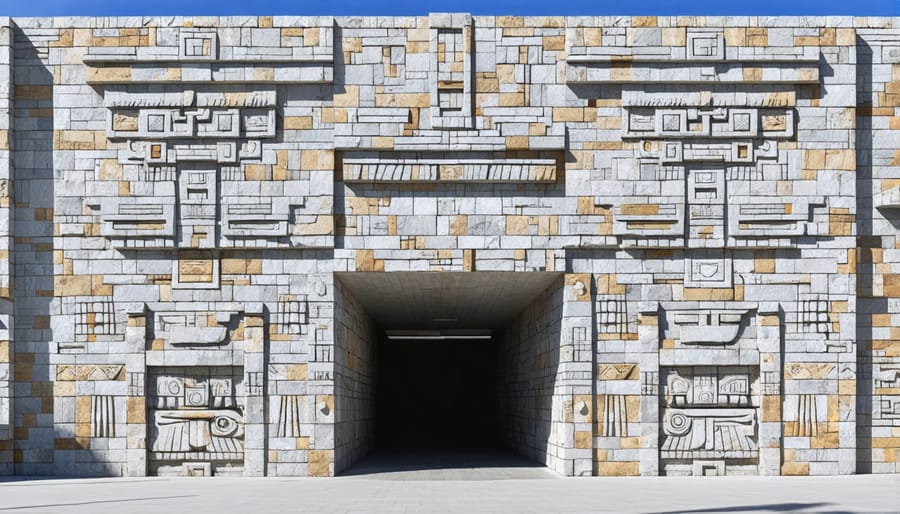
Preservation Techniques
The preservation of Aztec stone art requires careful attention to both traditional methods and modern preservation technologies. Conservation experts employ a combination of techniques to protect these invaluable artifacts from environmental damage, weathering, and natural deterioration.
Primary preservation methods include controlled environmental conditions, regular cleaning using non-abrasive materials, and protective coatings that prevent moisture infiltration while allowing the stone to breathe. Conservators carefully monitor humidity levels and temperature fluctuations, as these factors can accelerate deterioration through mineral crystallization and microbial growth.
Documentation plays a crucial role in preservation efforts. Detailed photogrammetry and 3D scanning create precise digital records of each artifact’s condition, allowing conservators to track changes over time and plan interventions effectively. When restoration is necessary, specialists use compatible materials that match the original stone’s composition and properties.
Preventive conservation measures include installing proper drainage systems around outdoor monuments, implementing visitor management strategies to reduce physical wear, and developing emergency response protocols for natural disasters. These comprehensive approaches ensure that future generations can continue to study and appreciate these masterpieces of Mesoamerican craftsmanship.
Design Tips for Aztec-Inspired Stone Features
When incorporating Aztec-inspired stone features into modern designs, it’s essential to balance authenticity with contemporary functionality. Start by selecting appropriate stone materials – limestone, basalt, or granite work well for recreating the dramatic textures and durability characteristic of Aztec stonework. Consider using rough-cut or split-faced finishes to echo the ancient stone preservation techniques while maintaining modern standards.
For wall features, implement stepped patterns reminiscent of Aztec pyramids using varying stone sizes. Create depth by alternating protruding and recessed stones, a technique that adds visual interest through natural shadow play. When designing decorative elements, incorporate geometric patterns like squares, triangles, and circular motifs common in Aztec symbolism.
Water features can draw inspiration from Aztec ceremonial fountains – consider channeled stone paths with gentle cascades or tiered basins. For pathways and patios, arrange stone pavers in radiating patterns that mirror Aztec calendar designs, using contrasting colors to define boundaries and create focal points.
Scale is crucial – while ancient Aztec architecture was monumentally sized, modern interpretations can be adapted for residential spaces. Use larger stones for statement pieces and smaller units for detailed work. When adding carved elements, focus on simplified versions of traditional motifs like serpents, eagles, or sun symbols.
For optimal durability, ensure proper installation with adequate drainage and appropriate sealants. Consider climate factors and maintenance requirements when selecting specific stone types and finishing techniques. This approach ensures your Aztec-inspired features remain both beautiful and functional for years to come.
The enduring legacy of Aztec stone art continues to influence modern design, architecture, and cultural expression. These masterful works, created centuries ago, demonstrate an exceptional understanding of material properties, spatial relationships, and symbolic representation that remains relevant today. Contemporary designers and architects frequently draw inspiration from Aztec motifs and patterns, incorporating them into modern buildings, interior spaces, and decorative elements.
The technical precision and artistic sophistication of Aztec stone carving serve as benchmarks for modern stonework, while their sustainable approach to material use offers valuable lessons for today’s environmental challenges. In museums worldwide, Aztec stone artifacts attract millions of visitors annually, testifying to their ongoing cultural significance and universal appeal.
The principles of balance, symmetry, and sacred geometry found in Aztec stone art continue to inform contemporary design practices. Their innovative techniques for stone processing and installation provide insights for modern construction methods, while their integration of natural elements with human-made structures remains a model for sustainable architecture. This ancient artistic tradition thus bridges past and present, offering timeless lessons in craftsmanship, symbolism, and architectural harmony.

